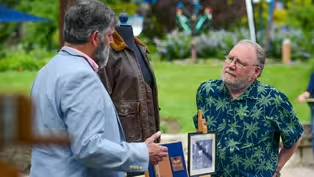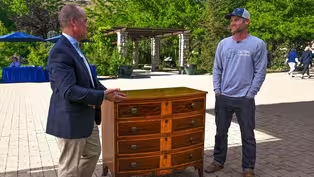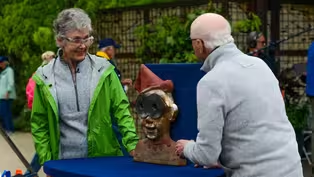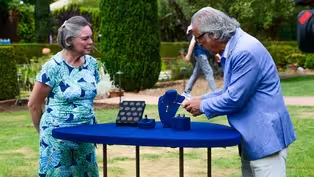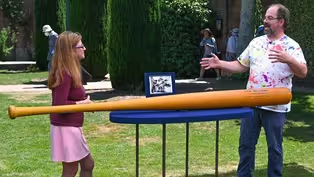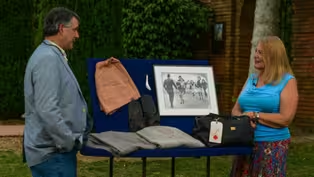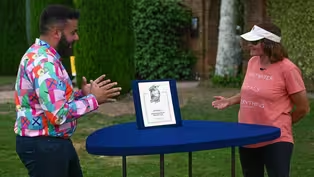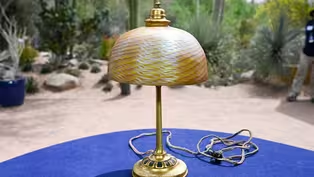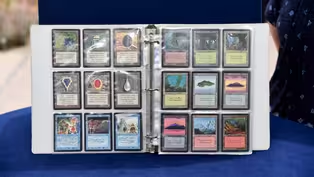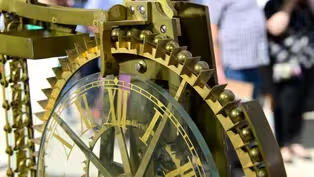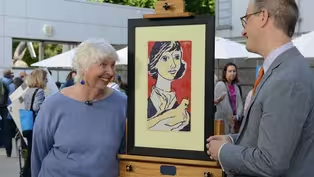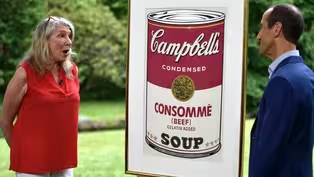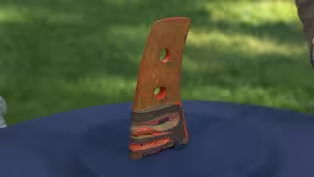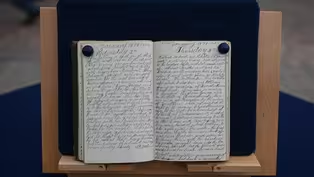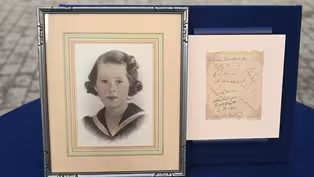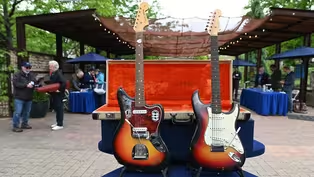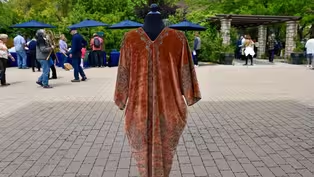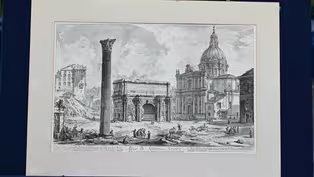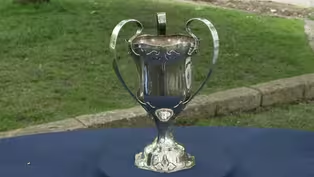
RECUT: Idaho Botanical Garden, Part 2
Special | 22m 31sVideo has Closed Captions
In this half-hour RECUT, watch breathtaking Boise appraisals at Idaho Botanical Garden.
In this half-hour RECUT, watch breathtaking Boise appraisals at Idaho Botanical Garden, including a Fortuny silk velvet jacket, ca. 1925, a 1909 Martin Parlor guitar, and a Northwest Coast Clan crest helmet. Learn which is $30,000.
Problems playing video? | Closed Captioning Feedback
Problems playing video? | Closed Captioning Feedback
Funding for ANTIQUES ROADSHOW is provided by Ancestry and American Cruise Lines. Additional funding is provided by public television viewers.

RECUT: Idaho Botanical Garden, Part 2
Special | 22m 31sVideo has Closed Captions
In this half-hour RECUT, watch breathtaking Boise appraisals at Idaho Botanical Garden, including a Fortuny silk velvet jacket, ca. 1925, a 1909 Martin Parlor guitar, and a Northwest Coast Clan crest helmet. Learn which is $30,000.
Problems playing video? | Closed Captioning Feedback
How to Watch Antiques Roadshow
Antiques Roadshow is available to stream on pbs.org and the free PBS App, available on iPhone, Apple TV, Android TV, Android smartphones, Amazon Fire TV, Amazon Fire Tablet, Roku, Samsung Smart TV, and Vizio.
Buy Now
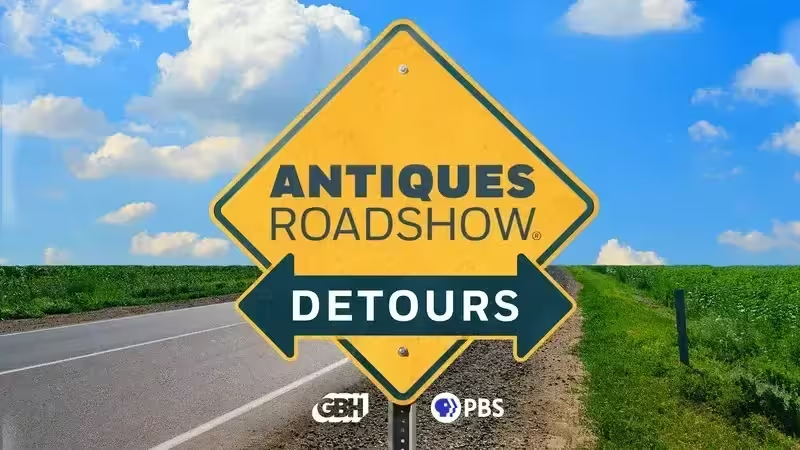
ANTIQUES ROADSHOW DETOURS
Ever wondered what happens to the treasures featured on America’s beloved ANTIQUES ROADSHOW after the cameras leave town? Host Adam Monahan tracks down the juicy afterlives of your favorite finds from PBS’s hit series.Providing Support for PBS.org
Learn Moreabout PBS online sponsorshipMore from This Collection
America’s favorite treasure hunt ANTIQUES ROADSHOW presents a bite-sized way to enjoy the show. ANTIQUES ROADSHOW RECUT features thirty-minute episodes, packed full of favorite finds and paced for maximum entertainment. RECUT features episodes recut from the show’s previous visits to distinctive and historic locations across the country.
RECUT: Idaho Botanical Garden, Part 4
Video has Closed Captions
Wrap up Season 4 of RECUT with a $50,000 appraisal at Idaho Botanical Garden! (22m 31s)
RECUT: Idaho Botanical Garden, Part 3
Video has Closed Captions
Visit the “City of Trees” for unbe-leaf-able Boise treasures in this half-hour RECUT. (22m 31s)
RECUT: Idaho Botanical Garden, Part 1
Video has Closed Captions
Gem State treasures sparkle in this half-hour RECUT at Idaho Botanical Garden! (22m 31s)
Video has Closed Captions
Watch wow-worthy Woodside finds in this half-hour RECUT and learn which is up to $44,000! (22m 24s)
Video has Closed Captions
In this half-hour RECUT episode, golden state treasures shine at Filoli. One is $150,000! (22m 23s)
Video has Closed Captions
Watch fascinating Filoli finds in this half-hour RECUT, including one up to $100,000! (22m 36s)
Video has Closed Captions
This season's first half-hour of RECUT wows our guests with a $200,000 to $330,000 find! (22m 30s)
RECUT: Desert Botanical Garden, Part 2
Video has Closed Captions
Phoenix treasures heat up, like one appraisal up to $35,000, in this half-hour RECUT! (22m 28s)
RECUT: Desert Botanical Garden, Part 1
Video has Closed Captions
Phenomenal Phoenix finds abound in this half-hour RECUT. One is worth up to $100,000! (22m 26s)
RECUT: Crocker Art Museum, Part 2
Video has Closed Captions
See stunning Sacramento finds like one $80,000-$125,000 treasure, in this half-hour RECUT! (22m 28s)
RECUT: Crocker Art Museum, Part 1
Video has Closed Captions
Head to California’s Crocker Art Museum for a bite-sized RECUT! One find is up to $75,000! (22m 27s)
RECUT: Winterthur Museum, Garden & Library, Part 2
Video has Closed Captions
Discover Delaware treasures in this half-hour RECUT, including one valued at $50,000! (22m 27s)
Providing Support for PBS.org
Learn Moreabout PBS online sponsorship♪ ♪ CORAL PEÑA: "Antiques Roadshow Recut" is digging up more gems at the Idaho Botanical Garden.
GUEST: I wasn't going to bring it 'cause I had to have something that fit in my purse.
(chuckles) (laughing): Oh, my God.
That's crazy.
♪ ♪ PEÑA: Welcome back to the Idaho Botanical Garden in the second half-hour of "Antiques Roadshow Recut."
The green space is Outlaw Field, which got its name because in the 1940s, while the area was still a part of the prison, it was used as a place for inmates to participate in sports like baseball, football, and basketball.
Today the space is used for outdoor concerts and events like "Antiques Roadshow."
What else turned up on our visit to the Garden?
Check it out.
♪ ♪ GUEST: I have a velvet kaftan from Fortuny, which, as I understand, is a couture design house in Italy.
It's from my great-grandmother, and was passed down from her to her daughter and then my mom and then to me.
It is by Mariano Fortuny, and he was born in 1871 to a family of very well-known artists in Granada, Spain.
Okay.
When his father died, his mother ended up moving the entire family to Venice, where he then continued to work for the rest of his life, and he died in '49.
As a family full of artists, they were inspired by textiles and things from around the world.
Mariano was specifically inspired by Persian textiles and Renaissance velvets.
What we have here is a silk velvet kaftan.
It is a T-shaped.
Going to lift up one of his very simple...
Simple long line, simple seam here, up the side.
It's open.
It was always meant to drape.
Soft as anything silk velvet.
It's so soft.
Fortuny is often identified with these amazing proprietary techniques.
In this example, it's actually how he stamped the metal onto the silk velvet.
We don't know how he did the metal stamping.
It's a mystery and it's luscious.
They still stamp things and it's still a secret.
It is a classic open, sort of, jacket robe.
It's in a very simple construction.
It's not about construction.
It's about the expression, the colors, and the, the motifs he's using, the inspiration.
His stamping is meant to... give that effect of what we see in brocaded Ottoman and Renaissance velvets.
Around the neck, we have the sort of tendrils, and an abstract floral of some sort.
Here it looks, we've got these roundels.
It's very reminiscent of a, of a Coptic, uh, tunic with these roundels.
At the bottom, we have a very wide printed area.
And what we see is these roundels are actually sort of a tree of life.
It's just a simple V in the back.
Meant to drape very elegantly over a very kind of bohemian woman.
Yes.
(chuckles) We see a small damage, which makes sense, it's a point of stress.
Aside from this stunning color, you always have a contrasting color.
This is a lovely taupe silk inside.
He opened his couture house in 1906, and sometimes it's hard to date these, because he did the same things for a, a long time.
It was circa 1925, circa 1930.
I was not able to find this exact pattern, but it, I don't believe this would have been a one-off design.
Color.
Yeah.
Lovely.
It's so stunning.
Really beautiful.
Color does not make a difference to the market.
Because you could wear this over anything.
Mm-hmm.
Right now on the market-- this is a retail price I'm going to give you... Mm-hmm.
...they are selling consistently in the $15,000, $16,000 range.
(laughing): Oh my God.
That's crazy.
Yeah.
Wow.
It's, they come up on the market, and they are beloved.
They are in museums all around the world.
Oh my gosh.
Many examples.
Wow.
They are, uh, very, very desirable.
I would put an insurance valuation of $18,000 on this.
If you had to replace it, yeah.
Wow.
GUEST: Well, we were at a, uh, yard sale about 15 years ago, and we bought some items from them and, uh, there was a, we went home, and there was a generator that I wanted.
So we went back, and the first visit, we saw the lamp, or I did-- and went back and bought the generator.
I said, "How much for the lamp?"
And the guy said, "If you want it, you can have it."
There's a lot of areas here where there's paint superimposed to reinforce structure that was already there.
Does that, you know, does that make sense?
Right, yeah.
So what it almost, it ends up looking like they're wearing makeup... Mm-hmm.
...because the color is much more intense.
Again, like makeup.
(chuckling): Like they put too much on, right?
Like it's caked over the top.
Um...
So they painted a painting.
GUEST: I've got two Fender guitars.
One's a Jaguar, one's a Stratocaster.
They belonged to my father.
Mm.
He started a band... with some friends.
Right.
He got tired of them being unreliable, so he decided to teach all of us kids an instrument.
Oh, wow, so he made a family band...
He made a family band.
...out of, out of you all.
Yes.
(laughs) And so he started out playing this guitar, the Stratocaster.
Right.
And then, decided to retire it and bought this Jaguar.
And then after he passed away, then I learned to play the guitar, and so this became my guitar.
We have the '64, 1964 Fender Stratocaster.
It's all original.
This one's in pretty good shape.
It has some nicks and dings, but it actually will clean up very well.
It's overall-- it doesn't show much play.
The Stratocaster was made starting in 1954.
So this is actually ten years into the life of this guitar model by Fender.
Okay.
The white case is for this particular guitar, because of the year: '64 is the only year they actually did this, which is actually late '63 model year to end of '64 is the only year you'll see these white cases.
The white cases.
The Jaguar came out in 1962.
This was its, this one's in 1965.
All original, as well.
This has the transition logo, 'cause this was actually made after Fender was sold.
In '65, Leo Fender sold the company to CBS.
And that's considered some sort of a benchmark as far as quality.
Most people want pre-CBS guitars.
I'm guessing, is... That's him?
"C.W."?
His initials, uh-huh.
Or it was "country western."
(laughs) It could stand for both.
One of the...
Right?
Both of these are, I would call, on a scale of one to ten, probably seven-and-a-half, 75% condition.
Okay.
They're good, but, you know, they have some...
Some wear.
They have some love.
There you go.
There you go.
I'd rather call it love than, like, wear.
This guitar, particularly this style, the Jaguar, and there's another model called the Jazzmaster that have, both have the same body shape, have become very trendy in the last few years.
They're popular with millennials and, and hipsters.
This is the iconic, the Stratocaster.
Yeah.
Some of the greatest players use these.
And this, at the time, when Fender came out with this guitar, this was the top-of-the-line.
There was, that was the most expensive guitar they had, was the Jaguar.
So your dad went full out...
He went full.
(chuckles) ...when he bought this.
Uh-huh.
These guitars...
It was probably around $400 new.
In that time period.
In that time period, '65 or so, which is a lot of money then.
This guitar now, at retail, even with the initials C.W., these are in the $5,000 to $7,000 range.
Okay.
The Stratocaster, new, this guitar was right at $300.
This guitar is in the $20,000 range.
Oh, really?
Yeah.
Wow.
So, this is...
This is your big boy.
Wow, yeah.
We, we figured that as much, but... Oh, did you?
I mean, that it was...
It was more expensive?
Yeah.
More expensive.
GUEST: So I brought a print by, I believe, an artist Piranesi.
One of my friends was getting rid of a bunch of stuff, and he had left this in his front porch, and it was about to rain, so I didn't want to get it wet.
So I took it, just home with me.
So you saved it.
(chuckles) (laughing): Yeah.
Yeah.
Did the friend you ha, got it from have any idea as to what it was?
No, he usually got stuff from estate sales, and he... Just anything that he wasn't interested in he tossed out.
And when did you save it from the rain?
Um, it was about five years ago.
It's been sitting in a cardboard box in our garage.
(chuckles) Oh.
I always thought it was something special, but I didn't really know much about it, and I wanted to find out more about it before I got it framed.
It's an etching by Giovanni Battista Piranesi, uh, who was a major Italian printmaker, the major architectural etcher of the 18th century, and actually a personal favorite of, of mine.
This print is from the, Piranesi's most famous series, the "Views of Rome," or the "Vedute di Roma," which was popular in his day and has been popular ever since.
It's the Arch of Septimius Severus in Rome.
We call that area-- basically through here-- the Roman Forum now, and this is the arch itself.
This ground is now probably ten or 15 feet lower.
Because the land kept flooding, and they never cleaned it out.
So it just was, all this junky soil was there.
They then excavated it out, and that arch is still there, and it looks a whole lot more impressive, uh, these days.
The print was first made in 1759 or 1760.
This is printed later, probably from the first Paris edition, published between 1800... Oh, wow.
...and 1807.
There's lots of different editions of the Piranesis, but in the, the first Paris edition, you're looking at somewhere in the mid- to high hundreds were, were printed.
Of each, um... Of each print.
Okay.
And then there are hundreds of prints in this series.
How did you know it was the Paris edition?
Partly it's the watermark is one way you tell, and another way, along the bottom that's his original address and the price.
They removed that in later editions.
The lack of the centerfold, because the early editions were almost always had centerfolds... Oh, okay.
Yeah.
And then, the later editions had extra numbers put on them.
You got sort of a junky mat here.
Yes.
(chuckling): But that's what it came with.
(chuckling): I, I haven't done anything with it.
Well, just, take it to a decent framer, get rid of that mat.
But otherwise, it's in very nice condition for a print of, of this era.
A retail value would be around $2,500 to $3,000.
Wow.
So I, I'm glad you saved it from the rain.
Yes.
Yes, thank you.
Well, it may be time to get it out of the garage.
(laughs) Yes, definitely.
♪ ♪ PEÑA: This contemporary English-style garden has a fountain that was dedicated to Diana, Princess of Wales, in 1997 to honor her life.
Nearby, the Summer House, a favorite spot for visitors, was built with materials reclaimed from old Boise buildings.
GUEST: This is a journal that was given to me by my grandmother, of, I believe, my great-great-great-grandfather, Lorus Bishop Pratt.
So, Lorus Bishop Pratt, the owner of this diary, his father is Orson Pratt.
And his brother is Parley Pratt.
And they were one of the first 12 disciples, I believe...
Uh, Apostles, of...
Apostles.
The Church of Jesus Christ of Latter-Day Saints.
Yes, so it, it, it's a special diary.
And this diary was when he was actually in England with his father, Orson.
I believe this is journal or diary number four.
Do you know what happened to the other diaries?
I don't know what happened to the other diaries.
My grandmother shared with me a letter from her brother, stating that they had donated their diary to Brigham Young University.
And they wrote a letter to my grandmother and gave her a copy of that diary, diary number two, saying, "This is what we did with ours.
We'd like you to donate yours, as well."
And she didn't, she chose not to.
And, she gave it to me... in secret.
When she gave it to me, I thought she just was giving me a copy of the transcript of diary number two.
And she gave it to me with the letter, and just said, "Just tuck this away.
Don't tell anybody that you have it."
And it wasn't until the COVID shutdown that I actually looked in the box and saw that there was more than just a copy of the transcript journal number two.
That there was this original diary there with it.
The LDS Church was founded in New York, 1830, with the publication of the first edition of the "Book of Mormon."
Joseph Smith appointed 12 men to be the original Apostles of the Mormon Church.
And that included your illustrious ancestors, Orson Pratt...
Yes.
...and his brother Parley P. Pratt.
Yes.
In 1879, the year after your diary takes place, the LDS Church published the first edition of the "Book of Mormon" that was put into chapter and verse since its inception and first publication in 1830.
Wow, and that was by Orson Pratt, right?
Yes, both Orson Pratt and his martyred brother, Parley P. Pratt, uh, was murdered decades earlier, not only were they two of the original Apostles of the church, they were also two of the leading intellectual lights of the Mormon Church in a very critical period, from Joseph Smith's assassination... Mm-hmm.
...to the death of Brigham Young, which was in 1877.
Oh, my goodness.
Without having the time to properly study the diary, that must be done...
...I believe, in a retail marketplace, this diary would fetch between $10,000 to $15,000.
Really?
Oh, my goodness, Ken.
No copies, no transcripts have ever been made of this diary.
Right.
If we find more interesting undiscovered history in it, it could drive the value up.
So maybe at auction, it might go as high as $15,000 to $25,000.
Wow, that's impressive.
It's, holds a lot of sentimental value to me, 'cause my grandmother trusted me with it.
(exhales) It's a 1909 Martin guitar.
A par, parlor guitar is what it's called.
MAN: And where'd you get it?
Ah, a girlfriend I knew rented a room from this guy and he had it in the garage.
And I go, "What do you want for the guitar?"
And he goes, "Oh, you can just have it."
So, got it for free.
♪ ♪ GUEST: That's my Great-Grandpa Roy's.
He was born in Missouri and ended up in Rockland, Idaho, and we don't really know anything before Great-Grandpa Roy.
It's a cavalry saber, copied after the model 1860.
It's a Civil War-era sword.
If you look on the ricasso, right here, it's Tiffany and Company.
This was imported into the United States...
Okay.
...from Europe, and then it was sold retail by Tiffany and Company.
An auction estimate on the sword would be in the $300 to $500 range.
Yeah, thanks for bringing it in today.
Yeah, thank you.
GUEST: I had an uncle who was a very fine artist, collected art, and he was a-- did restorations of, of art, and he was working on, uh, Hearst, some Hearst paintings.
Phoebe Hearst had a lot of Indian baskets and, and Indian things.
(laughs) Yeah.
Yeah.
He saw Phoebe's collection, and was able to purchase some of the baskets, and this was also included.
Because I liked art, he went ahead and, and did a painting of this and sent me what was the original.
I understand it might have been on a helmet, but it's, at least the top part.
Do you have a feeling for tribal identity?
Uh, I think it might be Native Alaskan.
Okay, it's from an area that we would call the Northern Northwest Coast.
And there were three tribes that were particularly remarkable in their cultural architecture, symbolism, artistry, and their cultural life: the Haida, the Tlingit, and the Tsimshian.
I believe this is either Tsimshian or Tlingit, two of the foremost tribes of that area.
And they excelled at carving wood and carving their clan symbols in wood in ceremonial regalia.
So, you're correct, this is the finial to a clan crest helmet.
And these clan crest helmets indicated who the individual was that was wearing it and what their lineage was.
So if you were a member of the Orca clan or the Bear clan, everybody that's o, observed this would immediately know.
And it would have been a man, in this case.
And he would have been, uh, someone of high regard.
I believe the top of the finial represents the fin of a killer whale or an orca.
The eye of the figure is humanoid.
The nostrils is, appear to be very, very ferocious.
They're expanded.
They're in almost an attack posture.
Uh-huh.
So there's a tremendous amount of energy being demonstrated there.
And then the lips are bared, the teeth are shown.
This would represent perhaps a warrior.
At the back, there are all of these little holes.
These would have contained tufts of human hair.
Wow.
And they would have been maybe three or four inches long.
And if this individual was standing in the wind, they would move.
If he was dancing, they would move.
They're pegged in with pieces of wood.
Do you have a feeling for the age here?
Based on the other collection that my uncle bought from Phoebe Hearst, somewhere between 1890 and perhaps the first part of the last century.
I, I think the Hearsts were collecting their baskets at just that period that you suggest.
And that's the height of the basketry market in, uh, from California all the way up to the coast.
This is older than that.
Really?
(clears throat): This may be as old as circa 1830.
Wow.
This, this is very old.
I'm surprised.
(laughs) Um, the sculptural quality is ex, superb.
The colors are great, they're rich.
The red reflects a vital color, of the blood, of lifelines.
Also spiritually associates with the upper powers, the powers of the upper world.
It's probably mercury vermilion, which is a trade, uh, pigment.
The copper green is a color derived from copper, like a copper oxide.
And then the black is a commercial pigment.
Hm.
I'm not sure what its nature was.
Mm-hmm.
This is, uh, as, as refined a sculpture as you're going to find on the coast of British Columbia.
It's just truly supreme.
Right.
On a retail basis, I would value this in the neighborhood of $30,000.
(laughing): Oh my God!
If this was the finial on top of a clan crest helmet, and we had the whole ensemble, we'd be in the neighborhood of perhaps of $150,000.
I wasn't going to bring it 'cause I had to have something to fit in my purse.
(laughs) GUEST: It was purchased in the '50s in, uh, San Francisco at a, uh, auction place.
And who purchased it?
An interior decorator for my mom.
This is a three-handled loving cup by Shreve and Company, circa 1910.
And this would have been made as a presentation piece.
It is marked on the bottom, "Shreve and Company, San Francisco."
And Shreve and Company was the pre-eminent jeweler and silversmith in San Francisco.
They started in about mid-19th century.
They're retailers at this point.
At about 1900 they start manufacturing their own silverwares.
Right about in this period is when we see the Arts and Crafts movement start to take off in America.
And one of the things that the Arts and Crafts movement was trying to do is to look back into handmade craftsmanship, in a period where there was a feeling that there was just too much manufacture and, and, and too much machine-made goods.
So this particular pattern is called 14th century, and it looks back into medieval strapwork... Mm.
...and medieval craftsmanship.
You can see all along the border this medieval motif.
Yeah.
Particularly on the rim on the bottom.
And this is all hand-hammered.
I think it's a great piece.
Do you have any idea of what you think it might be worth?
I'd guess, with the silver price and everything, maybe a couple thousand dollars.
It is quite heavy, so I, I think you're on the right track with that.
However, this is much more than just a piece of silver.
This is a beautiful piece of Arts and Crafts from Shreve and Company, and I would probably value this at auction... between $5,000 and $10,000.
(chuckling) Well, thank you very much.
Thank you.
That's exciting.
PEÑA: Thanks for watching.
See you next time, on "Antiques Roadshow Recut."
Appraisal: 1830 Northwest Coast Clan Crest Helmet Finial
Video has Closed Captions
Clip: Special | 4m 9s | Appraisal: Northwest Coast Clan Crest Helmet Finial, ca. 1830 (4m 9s)
Appraisal: 1877 - 1878 Lorus Bishop Pratt Journal
Video has Closed Captions
Clip: Special | 3m 45s | Appraisal: 1877 - 1878 Lorus Bishop Pratt Journal (3m 45s)
Appraisal: 1934 All-American Baseball Team Autographs
Video has Closed Captions
Clip: Special | 3m | Appraisal: 1934 All-American Baseball Team Autographs (3m)
Appraisal: 1965 Fender Jaguar & 1964 Stratocaster
Video has Closed Captions
Clip: Special | 3m 46s | Appraisal: 1965 Fender Jaguar & 1964 Stratocaster (3m 46s)
Appraisal: Fortuny Silk Velvet Jacket, ca. 1925
Video has Closed Captions
Clip: Special | 3m 54s | Appraisal: Fortuny Silk Velvet Jacket, ca. 1925 (3m 54s)
Appraisal: Giovanni Battista Piranesi Print, ca. 1800
Video has Closed Captions
Clip: Special | 3m 10s | Appraisal: Giovanni Battista Piranesi Print, ca. 1800 (3m 10s)
Appraisal: Shreve & Co. Sterling Silver Loving Cup, ca. 1910
Video has Closed Captions
Clip: Special | 3m 5s | Appraisal: Shreve & Co. Sterling Silver Loving Cup, ca. 1910 (3m 5s)
Providing Support for PBS.org
Learn Moreabout PBS online sponsorship
- Home and How To

Hit the road in a classic car for a tour through Great Britain with two antiques experts.













Support for PBS provided by:
Funding for ANTIQUES ROADSHOW is provided by Ancestry and American Cruise Lines. Additional funding is provided by public television viewers.


